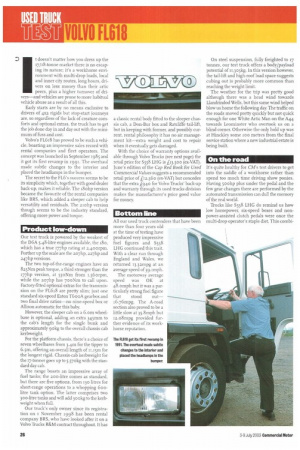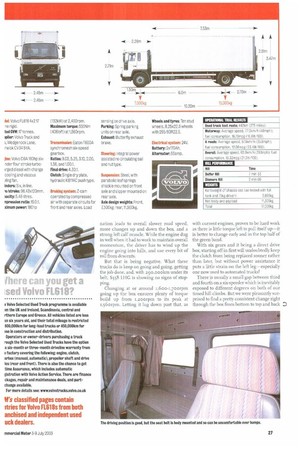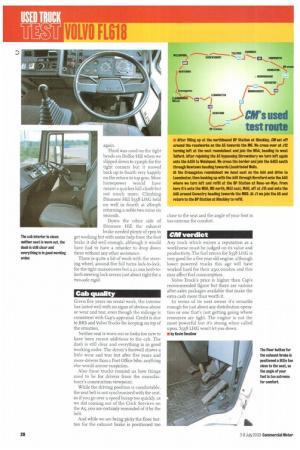t doesn't matter how you dress up the 17/18-tonne market
Page 26

Page 27

Page 28

If you've noticed an error in this article please click here to report it so we can fix it.
there is no escaping its nature; it's a workhorse environment with multi-drop loads, local and inner city routes, long hours, drivers on less money than their artic peers, plus a higher turnover of drivers—and vehicles are prone to more habitual vehicle abuse as a result of all this.
Early starts are by no means exclusive to drivers of 4x2 rigids but stop-start journeys are, so regardless of the lack of creature comforts and optional extras, the truck has to get the job done day in and day out with the minimum of fuss and cost.
Volvo's FL618 has proved to be such a vehicle, boasting an impressive sales record with rental companies and fleet operators. The concept was launched in September '985 and it got its first revamp in 1991. The overhaul made subtle changes to the interior and placed the headlamps in the bumper.
The secret to the FL6's success seems to be its simplicity which, together with good dealer back-up, makes it reliable. The i8ohp version became the favourite of the rental companies like B RS, which added a sleeper cab to help versatility and residuals. The 2iohp version though seems to be the industry standard, offering more power and torque.
Product low-down
Our test truck is powered by the weakest of the D6A 5.48-litre engines available, the 18o, which has a true 177hp rating at 2,400rpm. Further up the scale are the 207hp, 227hp and 247hp versions.
The two top-of-the-range engines have an 825 Nm peak torque, a third stronger than the 177hp version, at 55 oNm from 1,560rpm, while the 2o7hp has 7ooNm to call upon. Factory-fitted optional extras for the transmission on the FL618 are pretty slim; just one standard six-speed Eaton T6 o oA gearbox and two final drive ratios—no nine-speed box or Allison automatic for this baby.
However, the sleeper cab on a 6. om wheelbase is optional, adding an extra 345mm to the cab's length for the single bunk and approximately 90kg to the overall chassis cab kerbweight.
For the platform chassis, there's a choice of seven wheelbases from 3.4m for the tipper to 6.5m, offering an overall length of ii.15ni for the longest rigid. Chassis-cab kerbweight for the 17-tonner goes up to 5,570kg with the standard day cab.
The range boasts an impressive array of fuel tanks; the 200-litre comes as standard, but there are five options, from 130 litres for short-range operations to a whopping 6o olitre tank option. The latter comprises two 30o-litre tanks and will add 30 okg to the kerbweight when full.
Our truck's only owner since its registration on i November 1998 has been rental company B RS, who have looked after it on a Volvo Trucks R&M contract throughout. It has a classic rental body fitted to the sleeper chassis cab, a Don-Bur box and Ratcliffe tail-lift, but in keeping with former, and possibly current, rental philosophy it has no air management kit—extra weight and cost to repair when it eventually gets damaged.
With the choice of warranty options available through Volvo Trucks (see next page) the retail price for S558 LHG is £13,500 (ex-VAT). June's edition of the Cap Red Book for Used Commercial Values suggests a recommended retail price of iI2.5 Go (ex-VAT) but concedes that the extra i94o for Volvo Trucks' back-up and warranty through its used trucks division makes the manufacturer's price good value for money.
Bottom line
All our used truck contenders that have been more than four years old at the time of testing have produced very impressive fuel figures and S558 LHG continued this trait. With a clear run through England and Wales, we returned 13.32mpg at an average speed of 39.1mph.
The motorway average speed was OK at 48.omph but it was a particularly strong fuel figure that stood out16.76mpg. The A-road section also proved to be a little slow at 35.8mph but i2.o8mpg provided further evidence of its workhorse reputation. On steel suspension, fully freighted to 17 tonnes, our test truck offers a body/payload potential of 11,305kg. In this version however, the tail-lift and high-roof load space suggests cubing out is probably more common than reaching the weight limit.
The weather for the trip was pretty good although there was a head wind towards Llandrindod Wells, but this same wind helped blow us home the following day. The traffic on the roads moved pretty quickly but not quick enough for one White Artic Man on the A44 towards Leominster who overtook us on a blind corner. Otherwise the only hold up was at Hinckley some _too metres from the final service station where a new industrial estate is being built.
On the road
It's quite healthy for CMs test drivers to get into the saddle of a workhorse rather than spend too much time driving show ponies. Having 5 oohp plus under the pedal and the few gear changes there are performed by the automated transmission can dull the memory of the real world.
Trucks like S558 LHG do remind us how low horsepower, six-speed boxes and nonpower-assisted clutch pedals were once the multi-drop operator's staple diet. This combi
nation leads to overall slower road speed, more changes up and down the box, and a strong left calf muscle. While the engine dug in well when it had to work to maintain overall momentum, the driver has to wind up the engine going into hills, and use every bit of roll from descents.
But that is being negative. What these trucks do is keep on going and going, getting the job done, and, with 290,000km under its belt, S558 LHG is showing no signs of stop
ping.
Changing at or around 1,600-1,700rpm going up the box ensures plenty of torque build up from 1,200rpm to its peak at 1,56 orpm. Letting it lug down past that, as with current engines, proves to be hard work as there is little torque left to pull itself up—it is better to change early and in the top half of the green band, With six gears and it being a direct drive box, starting off in first will undoubtedly keep the clutch from being replaced sooner rather than later, but without power assistance it puts a little strain on the left leg—especially one now used to automated trucks!
There is usually a small gap between third and fourth on a six-speeder which is inevitably exposed to different degrees on both of our timed hill climbs. But we were pleasantly surprised to find a pretty consistent change right through the box from bottom to top and back
again.
Third was used on the tight bends on Dolfor Hill when we slipped down to 15mph for the tight corners but it moved back up to fourth very happily on the return to top gear. More horsepower would have meant a quicker hill climb but not much more. Climbing Dinmore Hill S558 LHG held on well in fourth at 28 mph returning a noble two mins six seconds.
Down the other side of Dinmore Hill the exhaust brake needed plenty of rpm to get working but with some help from the foot brake it did well enough, although it would have had to have a retarder to drop down there without any other assistance.
There is quite a bit of work with the steering wheel, around five full turns lock-to-lock, for the tight manoeuvres but a 2i.om kerb-tokerb steering lock seems just about right for a two-axle rigid.
Cab quality
Given five years on rental work, the interior has lasted well with no signs of obvious abuse or wear and tear, even though the mileage is consistent with Cap's appraisal. Credit is due to B RS and Volvo Trucks for keeping on top of the situation.
Neither seat is worn out or looks too new to have been recent additions to the cab. The dash is still clear and everything is in good working order. The driver's footwell shows a little wear and tear but after five years and more drivers than a Post Office bike, anything else would arouse suspicion.
Also these trucks remind us how things used to be for drivers from the manufacturer's construct on viewpoint.
While the driving position is comfortable, the seat belt is not synchronised with the seat, so if you go over a speed bump too quickly, as we did coming out of the Crick Services on the A5, you are certainly reminded of it by the belt And while we are being picky the floor button for the exhaust brake is positioned too close to the seat and the angle of your foot is too extreme for comfort.
CM verdict
Any truck which enjoys a reputation as a workhorse must be judged on its value and productivity. The fuel return for 5558 LHG is very good for a five year old engine, although lower powered trucks this age will have worked hard for their 290,000km and this may affect fuel consumption.
Volvo Truck's price is higher than Cap's recommended figure but there are various after-sales packages available that make the extra cash more than worth it.
In terms of its next owner it's versatile enough for just about any distribution operation or one that's just getting going where resources are tight. The engine is not the most powerful but it's strong when called upon. S558 LHG won't let you down.
• by Kevin Wallow




































































































































































